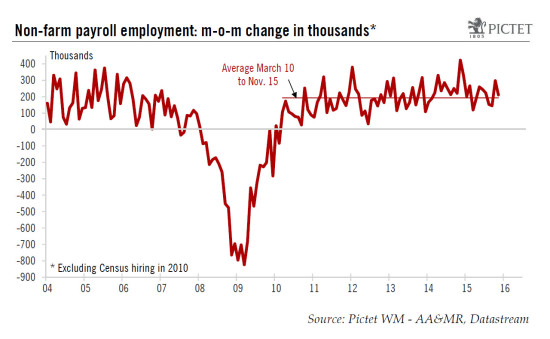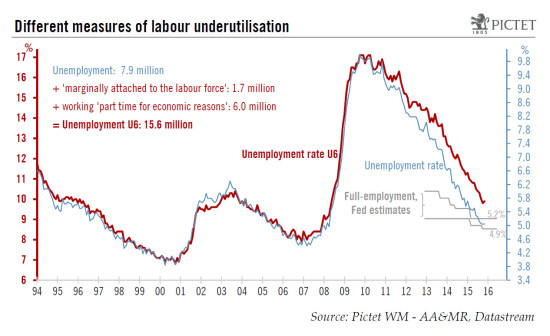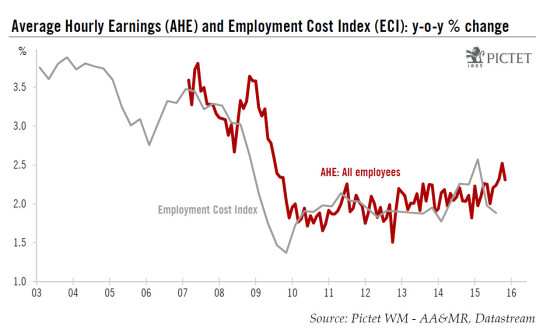Today’s employment report coupled with yesterday’s downward move in the trade-weighted USD following ECB decisions has probably settled the case for a December hike. November’s employment report was healthy. Job creation came in above expectations, with upward revisions for the previous two months. The unemployment rate (stable at 5.0%) and wages (+0.2% m-o-m) were in line with consensus expectations. The Fed will most probably hike rates in December. Non-farm payroll employment rose by a solid 211,000 m-o-m in November 2015, above consensus expectations (200,000). Moreover, October’s figure was revised up (from 271,000 to 298,000), as was September’s number (from 137,000 to 145,000). Cumulative net revisions thus worked out at a positive 35,000. Job creations are very volatile in the short run (see chart above) and are often significantly revised. Over the past three months, job creation has averaged 218,000, almost the same pace as over the previous three months (207,000), and slightly above the average recorded since employment bottomed in February 2010 (192,000). So far this year, employment has grown at an annualised rate of 1.8%, a pretty solid rate considering GDP has grown at around 2.2% over the same period.
Topics:
Bernard Lambert considers the following as important: Macroview, Uncategorized
This could be interesting, too:
Claudio Grass writes The Case Against Fordism
Claudio Grass writes “Does The West Have Any Hope? What Can We All Do?”
Claudio Grass writes Predictions vs. Convictions
Claudio Grass writes Swissgrams: the natural progression of the Krugerrand in the digital age
Today’s employment report coupled with yesterday’s downward move in the trade-weighted USD following ECB decisions has probably settled the case for a December hike.
November’s employment report was healthy. Job creation came in above expectations, with upward revisions for the previous two months. The unemployment rate (stable at 5.0%) and wages (+0.2% m-o-m) were in line with consensus expectations. The Fed will most probably hike rates in December.
Non-farm payroll employment rose by a solid 211,000 m-o-m in November 2015, above consensus expectations (200,000). Moreover, October’s figure was revised up (from 271,000 to 298,000), as was September’s number (from 137,000 to 145,000). Cumulative net revisions thus worked out at a positive 35,000. Job creations are very volatile in the short run (see chart above) and are often significantly revised. Over the past three months, job creation has averaged 218,000, almost the same pace as over the previous three months (207,000), and slightly above the average recorded since employment bottomed in February 2010 (192,000). So far this year, employment has grown at an annualised rate of 1.8%, a pretty solid rate considering GDP has grown at around 2.2% over the same period. With the economy approaching full employment, a gradual slowdown in job creation should occur in 2016, hopefully accompanied by some pick-up in productivity growth.
Unemployment rate stabilised at 5.0%
Meanwhile, the unemployment rate remained stable at 5.0% in November (5.05% before rounding), in line with consensus expectations. A more in-depth look at the household survey (the basis for calculating the unemployment rate) reveals that this stability reflects both robust employment growth and robust growth in the labour force. Employment as measured in the household survey – an often very volatile statistic – increased by 244,000 m-o-m in November whilst, at the same time, the size of the labour force rose slightly more by 273,000. The end-result was that the number of unemployed inched back up by a marginal 29,000 (273,000 minus 244,000) while the participation rate bounced back from 62.4% in October to 62.5% in November. The fact that the unemployment rate didn’t decline was therefore linked to a rebound in the participation rate, not to a soft employment number. In any case, at 5.05%, the unemployment rate for the third month in a row remained exactly in the middle of the range that the Fed feels corresponds to full employment (4.9%-5.2%).
The Fed has admittedly repeated many times that the unemployment rate probably underestimates the amount of resources available in the labour market. However, even if we consider a wider measure of unemployment, i.e. the U6 measure – which includes (1) employees working part-time, but who would prefer a full-time job, and (2) people who want a job, are available for work, have looked for a job sometime over the past 12 months, but did not do so during the current survey week and were therefore not counted as unemployed – it has fallen heavily so far this year. Admittedly, it bounced back a little from 9.8% in October to 9.9% in November. However, the rate recorded in November was still below what was registered in September (10.0%). The downward trend looks intact and, on this yardstick too, full employment does not look all that far away (see chart above).
Wage increases in line with expectations
Meanwhile, average hourly earnings increased by 0.2% m-o-m in November, in line with consensus estimates (+0.2%). On a y-o-y basis, wage increases fell back from 2.5% in October to 2.3% in November. However, October’s figure was the highest recorded since July 2009. This series is quite volatile (see chart at top of next page) but, according to these numbers, the pace of wage increases seems to have picked up modestly in October-November. Meanwhile, the quarterly Employment Cost Index (ECI) – the most reliable measure of wages and salaries – is pointing to no noticeable acceleration in wage increases so far this year. However, data for Q4 have not yet been published. In any case, we continue to expect wage increases to gradually pick up further over the coming few quarters.
The average workweek eased from 34.6 hours in October (revised up from 34.5) to 34.5 hours in November. As a consequence, the index of ‘aggregate weekly payrolls’ (calculated as a product of aggregate hours worked and average hourly earnings) rose only by a meagre 0.1% m-o-m in November. However, it followed a massive 0.9% increase in October (revised up from +0.6%). The end result was that this index – which is a good proxy for nominal household income coming in the form of private wages and salaries – grew by a strong 5.1% annualised between Q3 and October-November, after a similarly strong increase of 5.1% q-o-q annualised in Q3. This remains a supportive development for growth in household income in Q4, and for consumer spending.
The case for a December hike seems settled
In a speech on Wednesday and in her testimony in Congress yesterday, Fed Chair Janet Yellen strengthened the case for a lift-off on December 16. She said that “were the FOMC to delay the start of policy normalization for too long, we would likely end up having to tighten policy relatively abruptly to keep the economy from significantly overshooting both of our goals. Such an abrupt tightening would risk disrupting financial markets and perhaps even inadvertently push the economy into recession”.
Today’s healthy employment report coupled with yesterday’s downward move in the trade-weighted dollar following ECB decisions has most probably settled the case for a December hike. Nevertheless, we continue to believe that as monetary conditions will probably tighten further, the pace of rate tightening after the initial hike will be particularly pedestrian. Our forecast that the target range on the Fed funds rate will end 2016 at 0.75%-1.00% (three 25bp hikes from now to end-2016) remains unchanged.



